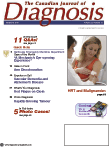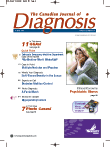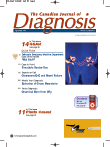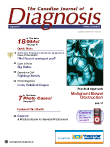The Canadian Journal of Diagnosis
2010 Back-Issues
2001 • 2002 • 2003 • 2004 • 2005 • 2006 • 2007 • 2008 • 2009 • 2010 • 2011 • 2012
Jan • Feb • Mar • Apr • May • June • July • Aug • Sept • Oct • Nov •Dec
|
|
|
|
December 2010, Volume 27, Number 12 Dalhousie Emergency Medicine Department Case in Point Experts on Call • Continuation of Clopidogrel What’s Your Diagnosis? Treatment Gaps in the Control of Asthma in Canada Photo Diagnosis • Rapidly Growing Tumour Hormone Replacement Therapy and Malignancies
|
|
|
|
|
November 2010, Volume 27, Number 11 Dalhousie Emergency Medicine Department Case in Point Experts on Call • Long-term Isotretinoin What’s Your Diagnosis? Photo Diagnosis • Lesions on Forehead A Pocket Guide for Family Physicians: Management of Osteoporosis Managing BPSD: Treating Agitation and Aggression in the Elderly Demented Patient
|
|
|
|
|
October 2010, Volume 27, Number 10 Dalhousie Emergency Medicine Department Case in Point What's Your Diagnosis Prevention of Vascular Events in High-risk Individuals: Optimal Use of Antiplatelet Therapies in Primary Care Experts on Call • Antidepressants During Pregnancy A Novel Therapeutic Approach to Chronic Lower Back Pain Photo Diagnosis • Muscular Weakness Endocrine Update Psychiatric Illness: Assessment and Management What is the Role of Genetics in Antiplatelet Therapy? Learnings from the European Society of Cardiology Congress, Stockholm, 2010 |
|
|
|
|
September 2010, Volume 27, Number 9 Dalhousie Emergency Medicine Department Case in Point Experts on Call • Management of Hyperparathyroidism What's Your Diagnosis Time to Re-examine the Management of Gout Photo Diagnosis • Hammer Toe Pain Related Sleep Difficulties in Fibromyalgia and Neuropathic Pain Bowel Obstruction is a common occurrence that most GPs are familiar with regarding its diagnosis and management. Although the majority of the population is at low risk there are several conditions that predispose its development. Dr. Susan MacDonald discusses how to manage the symptoms of bowel obstruction in order to help alleviate pain and suffering. |
|
|
|
|
August 2010, Volume 27, Number 8 Dalhousie Emergency Medicine Department Case in Point Experts on Call • Returning To Sport after Concussion Photo Diagnosis • Papules on Buttocks Practical Approach to Management of Malignant Bowel Obstruction Bowel Obstruction is a common occurrence that most GPs are familiar with regarding its diagnosis and management. Although the majority of the population is at low risk there are several conditions that predispose its development. Dr. Susan MacDonald discusses how to manage the symptoms of bowel obstruction in order to help alleviate pain and suffering. Cancer: A Practical Guide for General Practioners Cancer is a common group of diseases that should not be scary, however, the word itself strikes fear in the eyes of most people. Bruce Colwell discusses the importance for General Practitioners to encourage their patients to get screened for cancer, as well as explains how one should approach an individual who has been diagnosed with cancer. |
|
|
|
|
July 2010, Volume 27, Number 7 Dalhousie Emergency Medicine Department Case in Point Experts on Call • Treating Mild Eczema What's Your Diagnosis Photo Diagnosis • Backache After a Fall An Update on: Osteoporosis ?Osteoporosis is being increasingly recognized as a common condition associated with significant morbidity and mortality. Osteoporosis Canada has developed guidelines identifying absolute fracture risk by age and BMD. Dr. Khan explains the evaluation and therapy of osteoporosis, osteonecrosis of the jaw, drugs affecting skeletal health and atypical fractures Neuropathic Pain: A Challenging Problem ?Pain is a subjective term for an unpleasant conscious experience. Its development involves multiple levels of the nervous system from sensory endings in the skin and organs to the thalamus and cerebral cortex. Neuropathic pain is a specific type of pain that arises from injury or disease of the nervous system. Dr. Zochodne discusses the important distinctions of pain, what is responsible for this pain and what exactly is neuropathic pain and how it is treated. |
|
|
|
|
June 2010, Volume 27, Number 6 Dalhousie Emergency Medicine Department Case in Point Experts on Call • Hypothyroidism and Non-Alcoholic Fatty Liver Disease What's Your Diagnosis Endocrine Update Photo Diagnosis • A Mass on the Back An Overview of Benign Paroxysmal Positional Vertigo Benign paroxysmal positional vertigo (BPPV) is the most common disorder of the peripheral vestibular system, with the most frequent age of onset between the fifth and seventh decades of life. Overall lifetime prevalence is reported as 2.4% (3.2% for females and 1.6% for males). Dr. Beyea and Dr. Parnes describe the causes, pathophysiology, diagnosis, including history and physical exam, management and follow-up of BPPV. Clinical Pearls in Dyslipidemia Management Referrals to specialized Lipid Clinics are now frequently used for more complex lipid disorders and for more problematic patient management issues. While evidence-based guidelines are the optimal way to manage lipid disorders in general, the approach to treating these types of challenging cases must be individualized. Dr. Sherman explains his approach to three such challenges in dyslipidemia management and explains the rationale for each. |
|
|
|
|
May 2010, Volume 27, Number 5 Dalhousie Emergency Medicine Department Case in Point Experts on Call • Treating Temporal Arteritis and Polymyalgia Rheumatica Sébastien Bergeron, MD, FRCPC; Pierre Nantel, MD, CSPQ; and Pavel Hamet, OQ, MD, PhD, FRCPC, FAHA, FRSM, FCAHS
Photo Diagnosis • Pink, Flat Papules Assessing Frailty in the Office Not all seniors age successfully—whereas some remain active, others become increasingly dependent on others. The term “frailty” is often used to describe seniors with overt disability and who require assistance with activities of daily living. Frailty also refers to seniors without overt disability but who are at increased risk of adverse health outcomes. Dr. Heckman describes what frailty is and how to assess and manage it. Rheumatoid Arthritis in the Real World: Key Messages from Databases and Registries The Latest Buzz Surrounding Allergy to Insect Stings Allergic reactions to insect stings constitute a significant medical problem, reported in up to 3% of adults and almost 1% of children. However, many fatalities are thought to go unrecognized and usually occur in those > 45-years-old, but also in very young children and often with no prior history of a reaction. Dr. Gerstner describes the insects and their venom, different clinical reactions, anaphylaxis and intradermal testing and venom immunotherapy.
|
|
|
|
|
April 2010, Volume 27, Number 4 Dalhousie Emergency Medicine Department Case in Point Experts on Call • Bartholin Cyst What’s Your Diagnosis? Mixed Dementia Photo Diagnosis • Asymptomatic Pigmentation What You Need to Know About Carpal Tunnel Syndrome Carpal tunnel syndrome (CTS) is a clinical diagnosis which occurs when compression of the median nerve occurs at the wrist. It is a cause of considerable discomfort and lost time from work. Dr. Boyle answers questions regarding the signs and symptoms of CTS, the anatomy of the median nerve, the role of electrodiagnostic testing and treatment of the syndrome. Why Perform Pulmonary Function Tests? It is estimated that 1,500 deaths occur annually due to ingestion of foreign bodies (FB) and 3,000 deaths occur annually due to complications of foreign material aspiration. Foreign body ingestion and aspiration can affect persons of any age, however, 80% of cases occur in children (six months to three-years-old). Dr. Tewfik explains the different kinds of ingested objects and provides basic management options. He also describes esophageal FB, disc batteries and airway FB. |
|
|
|
March 2010, Volume 27, Number 3 Dalhousie Emergency Medicine Department Case in Point Experts on Call • Developing Rashes From Hot Tubs What's Your Diagnosis
Photo Diagnosis • Slowly Enlarging Brown Plaque Late-Onset Male Hypogonadism: Testosterone in the Aging Male Hypogonadism in older men presents as symptoms and is confirmed by a low serum testosterone done in a reliable assay. Dr. Corenblum explains that such men should receive testosterone replacement therapy (TRT), if no contraindications, at least as a trial. TRT should be discontinued if there is no symptomatic improvement. Men with symptoms with a normal serum testosterone should not receive TRT. Foreign Bodies in Otolaryngology It is estimated that 1,500 deaths occur annually due to ingestion of foreign bodies (FB) and 3,000 deaths occur annually due to complications of foreign material aspiration. Foreign body ingestion and aspiration can affect persons of any age, however, 80% of cases occur in children (six months to three-years-old). Dr. Tewfik explains the different kinds of ingested objects and provides basic management options. He also describes esophageal FB, disc batteries and airway FB. H1N1 2009 Influenza Virus: Management in an Outpatient Setting Since the onset of the first wave of the pandemic (H1N1) 2009 influenza virus, considerable efforts have been made to develop plans for management of patients in an acute care setting. Dr. Wong describes the symptoms associated with the H1N1 virus, the laboratory diagnosis, infection and prevention control and treatment issues. |
|
|
|
|
February 2010, Volume 27, Number 2 Dalhousie Emergency Medicine Department Case in Point Experts on Call • Canadian Recommendations for Mammography Photo Diagnosis • A Pigmented Lesion Fatigue: Investigation and Management Fatigue is physical and/or mental exhaustion that can be triggered by stress, medication, overwork, or mental and physical illness or disease. While frequently self-limiting or resolving, it can represent an important diagnostic and therapeutic challenge. Dr. Workman describes the patients' history, medications available, examination techniques and management options for fatigue. Congress Reporter Novel Therapies for Type 2 Diabetes Management Type 2 diabetes mellitus is a chronic progressive vascular disease with significant physical, economic and societal burden. Its prevalence is growing rapidly, particularly in developing countries. An estimated 285 million people worldwide are affected by diabetes. More than three million Canadians have diabetes and this number is expected to reach 3.7 million by 2020. Dr. Elsharif and Dr. Chetty discuss the incretin effect, how to improve glycemic control and expand on different GLP-1 receptor agonists and DPP-4 inhibitors. |
|
|
|
|
January 2010, Volume 27, Number 1 Dalhousie Emergency Medicine Department Case in Point Experts on Call • Photodynamic Therapy for Acne What's Your Diagnosis? Endocrine Update
Photo Diagnosis • Painful Ears Asymptomatic Microscopic Hematuria: Work-Up and Treatment Blood in the urine (hematuria) can originate from anywhere in the urinary tract or may be due to pathology outside the urinary tract and may be either gross or microscopic. The prevalence of asymptomatic microscopic hematuria (AMH) is 0.19% to 16.1%. Dr. Shahani and Dr. Matsumoto discuss the work-up and treatment of AMH, as well as when to refer to a nephrologist |
|












